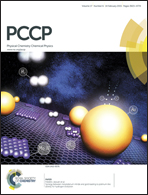Density functional theory study on boron- and phosphorus-doped hydrogen-passivated silicene
Abstract
When silicene is passivated by hydrogen, a bandgap occurs so that it becomes a semiconductor. Analogous to all the other semiconductors, doping is highly desired to realize the potential of hydrogen-passivated silicene (H-silicene). In the framework of density functional theory (DFT), we have studied the doping of H-silicene with boron (B) and phosphorus (P). The concentration of B or P ranges from 1.4% to 12.5%. It is found that the doping of B or P enables the indirect-bandgap H-silicene to be a semiconductor with a direct bandgap. With the increase of the concentration of B or P, both the valence band and the conduction band shift to lower energies, while the bandgap decreases. Both B- and P-doping lead to the decrease of the effective mass of holes and electrons in H-silicene. For both B- and P-doped H-silicene a subband absorption peak may appear, which blueshifts with the increase of the dopant concentration.


 Please wait while we load your content...
Please wait while we load your content...